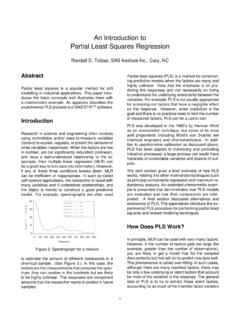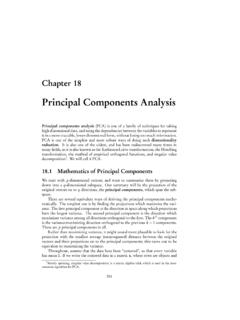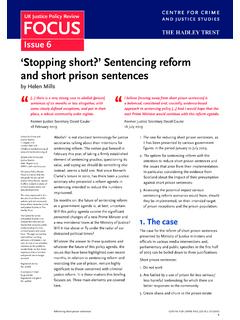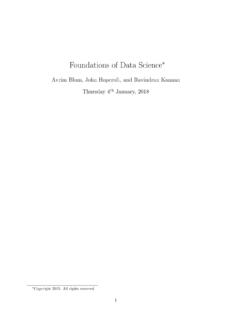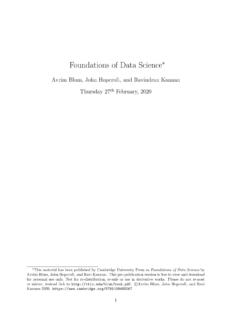Transcription of Robust Principal Component Analysis? - Columbia University
1 11 Robust Principal Component Analysis? EMMANUEL J. CAND`ES and XIAODONG LI, Stanford UniversityYI MA, University of Illinois at Urbana-Champaign, Microsoft Research AsiaJOHN WRIGHT, Microsoft Research AsiaThis article is about a curious phenomenon. Suppose we have a data matrix, which is the superposition of alow-rank Component and a sparse Component . Can we recover each Component individually? We prove thatunder some suitable assumptions, it is possible to recover both the low-rank and the sparse componentsexactlyby solving a very convenient convex program calledPrincipal Component Pursuit; among all feasibledecompositions, simply minimize a weighted combination of the nuclear norm and of the 1norm.
2 This sug-gests the possibility of a principled approach to Robust Principal Component analysis since our methodologyand results assert that one can recover the Principal components of a data matrix even though a positivefraction of its entries are arbitrarily corrupted. This extends to the situation where a fraction of the entriesare missing as well. We discuss an algorithm for solving this optimization problem, and present applicationsin the area of video surveillance, where our methodology allows for the detection of objects in a clutteredbackground, and in the area of face recognition, where it offers a principled way of removing shadows andspecularities in images of and Subject Descriptors: [Mathematics of Computing]: Numerical analysis Convexoptimization.
3 [Mathematics of Computing]: Probability and Statistics Robust regressionGeneral Terms: Algorithms, TheoryAdditional Key Words and Phrases: Principal components, robustness vis-a-vis outliers, nuclear-norm mini-mization, 1-norm minimization, duality, low-rank matrices, sparsity, video surveillanceACM Reference Format:Cand`es, E. J., Li, X., Ma, Y., and Wright, J. 2011. Robust Principal Component analysis ? J. ACM 58, 3,Article 11 (May 2011), 37 MotivationSuppose we are given a large data matrixM, and know that it may be decomposed asM=L0+S0,E. J. Cand`es was supported by ONR grants N00014-09-1-0469 and N00014-08-1-0749 and by the WatermanAward from NSF.
4 Y. Ma was partially supported by the grants NSF IIS 08-49292, NSF ECCS 07-01676, andONR addresses: E. J. Cand`es and X. Li, Departments of Mathematics and Statistics, Stanford University ,450 Serra Mall, Building 380, Stanford, CA 94305; email:{candes, Y. Ma, Depart-ment of Electrical and Computer Engineering, University of Illinois at Urbana-Champaign, 145 CoordinatedScience Laboratory, 1308 West Main Street, Urbana, IL61801, and Visual Computing Group, Microsoft Re-search Asia, Building 2, No. 5 Dan Ling Street, Beijing, China 100080; email: J. Wright,Visual Computing Group, Microsoft Research Asia, Building 2, No.}
5 5 Dan Ling Street, Beijing, China 100080;email: to make digital or hard copies of part or all of this work for personal or classroom use is grantedwithout fee provided that copies are not made or distributed for profit or commercial advantage and thatcopies show this notice on the first page or initial screen of a display along with the full citation. Copyrights forcomponents of this work owned by others than ACM must be honored. Abstracting with credit is copy otherwise, to republish, to post on servers, to redistribute to lists, or to use any Component of thiswork in other works requires prior specific permission and/or a fee.
6 Permissions may be requested fromPublications Dept., ACM, Inc., 2 Penn Plaza, Suite 701, New York, NY 10121-0701 USA, fax+1 (212)869-0481, or 2011 ACM 0004-5411/2011/05-ART11 $ of the ACM, Vol. 58, No. 3, Article 11, Publication date: May :2E. J. Cand`es et low rank andS0is sparse; here, both components are of arbitrary magni-tude. We do not know the low-dimensional column and row space ofL0, not even theirdimension. Similarly, we do not know the locations of the nonzero entries ofS0,noteven how many there are. Can we hope to recover the low-rank and sparse componentsboth accurately (perhaps even exactly) and efficiently?
7 Aprovably correctandscalablesolution to the above problem would presumablyhave an impact on today s data-intensive process of scientific recentexplosion of massive amounts of high-dimensional data in science, engineering, andsociety presents a challenge as well as an opportunity to many areas such as image,video, multimedia processing, web relevancy data analysis , search, biomedical imagingand bioinformatics. In such application domains, data now routinely lie in thousandsor even billions of dimensions, with a number of samples sometimes of the same orderof alleviate the curse of dimensionality and scale,2we must leverage on the factthat such data have low intrinsic dimensionality, for example, that they lie on somelow-dimensional subspace [Eckart and Young 1936], are sparse in some basis [Chenet al.]
8 2001], or lie on some low-dimensional manifold [Tenenbaum et al. 2000; Belkinand Niyogi 2003]. Perhaps the simplest and most useful assumption is that the dataall lie near some low-dimensional subspace. More precisely, this says that if we stackall the data points as column vectors of a matrixM, the matrix should (approximately)have low rank: mathematically,M=L0+N0,whereL0has low-rank andN0is a small perturbation matrix. ClassicalPrincipalComponent analysis (PCA) [Hotelling 1933; Eckart and Young 1936; Jolliffe 1986]seeks the best (in an 2sense) rank-kestimate ofL0by solvingminimize M L subject torank(L) k.
9 (Throughout this article, M denotes the 2-norm; that is, the largest singular valueofM.) This problem can be efficiently solved via the singular value decomposition(SVD) and enjoys a number of optimality properties when the noiseN0is small andindependent and identically distributed is arguably the most widely used statistical tool for data analysisand dimensionality reduction today. However, its brittleness with respect togrosslycorrupted observations often puts its validity in jeopardy a single grossly corruptedentry inMcould render the estimated Larbitrarily far from the trueL0. Unfortunately,gross errors are now ubiquitous in modern applications such as image processing, webdata analysis , and bioinformatics, where some measurements may be arbitrarily cor-rupted (due to occlusions, malicious tampering, or sensor failures) or simply irrelevantto the low-dimensional structure we seek to identify.
10 A number of natural approachesto robustifying PCA have been explored and proposed in the literature over severaldecades. The representative approaches include influence function techniques [Huber1981; Torre and Black 2003], multivariate trimming [Gnanadesikan and Kettenring1972], alternating minimization [Ke and Kanade 2005], and random sampling tech-niques [Fischler and Bolles 1981]. Unfortunately, none of these approaches yields a1 Data-intensive computing is advocated by Jim Gray as the fourth paradigm for scientific discovery [Heyet al. 2009].2We refer to either the complexity of algorithms that increases drastically as dimension increases, or to theirperformance that decreases sharply when scale goes of the ACM, Vol.










